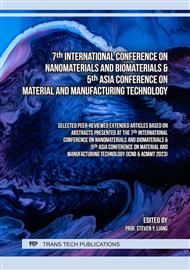p.3
p.11
p.21
p.29
p.37
p.45
p.53
p.61
p.73
A Comparative Study of Lubrication Performance for Bs 080M46 Medium Carbon Steel Using Ring Compression Test and Finite Element Simulation
Abstract:
This study investigates the impact of lubrication on friction factors during the hot ring compression test of BS 080M46 medium carbon steel. Hot forging processes are crucial in industries due to the strength and durability of forged products, but friction-related issues can arise. Four lubrication conditions are focused: dry, oil to black graphite, water to black graphite, and water to colorless graphite. The ring compression test procedure, including sample dimensions and lubrication application, is explained. By employing predictive calibration curves generated through FEM which monitored height and internal diameter changes during compression. The study successfully aligns FEM simulation results with experimental data, thereby enhancing the accuracy of friction factor estimations and visualizing material behavior under various lubrication conditions. Results indicate that lubrication significantly affects friction factors, with oil to black graphite performing the best, yielding a friction factor of 0.15. A comparison between theoretical and experimental friction factors shows varying agreement levels, with water-to-black graphite, and water-to-colorless graphite respectively demonstrating excellent alignment with 0.990% and 0.971%. This study has practical implications for selecting lubricants in industrial applications, potentially enhancing manufacturing processes and product quality.
Info:
Periodical:
Pages:
37-44
Citation:
Online since:
February 2024
Keywords:
Price:
Сopyright:
© 2024 Trans Tech Publications Ltd. All Rights Reserved
Share:
Citation:



